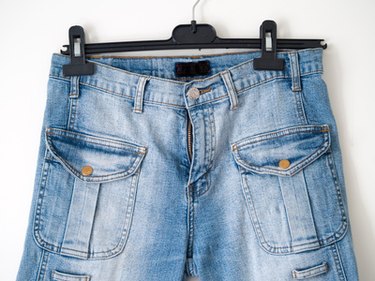
Denim jeans are one of the most common articles of clothing found in most people's wardrobes, yet few know how the fabric is made or the origin of this popular type of clothing that has survived years of changes in the fashion industry.
What Is Denim?
Video of the Day
Denim is made from tightly woven fabric that usually comes from cotton warp yarn and white cotton filling yarn. The filling yarns are stretched across the width of the fabric and interlaced at 90-degree angles with warp yarns, which are also stretched the length of the fabric. This creates an interwoven pattern of diagonal lines called “twill weave.” There are two kinds of twill weaves: left hand twill, which is softer and runs diagonally from right to left, and right hand twill, which runs diagonally from left to right and is flatter and smoother.
Video of the Day
Modern Denim
Although denim fabric was originally made from only cotton, today it also includes polyamide, lycra, polypropylene, polyester or nylon for stretch and durability. The fabric is also sometimes given special coatings or rubberized effects to create a different appearance. Some denim fabrics are also made lighter by adding linen, hemp or wool.
Why It Is Usually Blue
Denim is usually dyed the color blue just like the original versions of jeans, which were created for workmen. Those jeans were traditionally dyed with indigo, which was known as the most significant natural dye and associated with practical fabrics and work clothing. New colors were introduced to denim fabrics in the 19th century when synthetic dyes were created.
Denim Treatments
Denim fabric is treated in a variety of ways to give it different aesthetics. For instance, manufacturers sometimes repeatedly pre-wash the fabric to make it softer, while stoned-washed denim originally involved pumice stones to give the fabric a more natural appearance. Today, the look of stone-washed denim is usually accomplished with ceramic balls, enzymes and sand. In addition, sand-blasted denim is sprayed with sand or chemicals to give it a worn look. Vintage or dirty denim fabrics are created with patterns, such as brown filler yarns that are added to the weaving.
The First Denim Jeans
The first denim jeans are credited to Levi Strauss, a German immigrant who went to California in 1853 and sold rough canvas for tents and wagon covers during the Gold Rush. When clients told him they needed pants that were strong enough to last in the mines, Strauss began making jeans from the rough canvas, switching to denim when miners complained of chafing. However, the first “blue jeans” weren't created until 1873, when Strauss joined forces with a tailor from Nevada named David Jacobs and co-patented the idea of using rivets to make the jeans stronger.
Where It Gets Its Name
A common theory about the origin of the word “denim” is that the fabric was originally created in the Middle Ages in Nîmes, France, under the name “serge de Nîmes”. The name was later shortened to “denim” when it reached the U.S. in the 1800s.